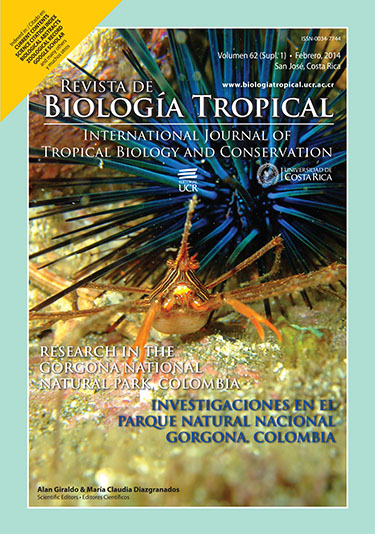Abstract
Carijoa riisei (Octocorallia: Cnidaria), a western Atlantic species, has been reported in the Pacific as an invasive species for nearly forty years. C. riisei has been recently observed overgrowing native octocorals at several rocky-coral littorals in the Colombian Tropical Eastern Pacific-(TEP). C. riisei has inhabited these reefs for at least 15 years but the aggressive overgrowth on other octocorals have been noted until recently. Here, we surveyed for the first time the distribution and inter-specific aggression by C. riisei in both coastal and oceanic areas colonized in the Colombian TEP (Malpelo, Gorgona and Cabo Corrientes), including preliminary multiyear surveys during 2007-2013. We observed community-wide octocoral mortalities (including local extinction of some Muricea spp.) and a steady occurrence of competing and overgrowing Pacifigorgia seafans and Leptogorgia seawhips. In Gorgona Island, at two different sites, over 87% (n=77 tagged colonies) of octocorals (Pacifigorgia spp. and Leptogorgia alba) died as a result of C. riisei interaction and/or overgrowth between 2011 and 2013. C. riisei overgrows octocorals with an estimate at linear growth rate of about 1cm m-1. The aggressive overgrowth of this species in TEP deserves more attention and regular monitoring programs. Rev. Biol. Trop. 62 (Suppl. 1): 199-207. Epub 2014 February 01.
References
Barrero-Canosa, J., Dueñas, L. F. & Sánchez, J. A. (2013). Isolation of Potential Fungal Pathogens in gorgonian corals at the Tropical Eastern Pacific. Coral Reefs, 32: 35-41.
Bayer, F. M. (1961). The shallow water Octocorallia of the West Indian region, Martinus Nijoff. The Hague, Netherlands.
Briggs, J. (2010). Marine biology: the role of accommodation in shaping marine biodiversity. Marine Biology, 157: 2117-2126.
Cadena, N. J. & Sánchez, J. A. (2010). Colony growth in the harvested octocoral Pseudopterogorgia acerosa in a Caribbean coral reef. Marine Ecology Progress Series, 31: 566-573.
Calcinai, B., Bavestrello, G. & Cerrano, C. (2004). Dispersal and association of two alien species in the Indonesian coral reefs: the octocoral Carijoa riisei and the demosponge Desmapsamma anchorata. Journal of the Marine Biological Association of the United Kingdom, 84: 937-941.
Concepcion, G. T., Kahng, S. E., Crepeau, M. W., Franklin, E. C., Coles, S. L. & Toonen, R. J. (2010). Resolving natural ranges and marine invasions in a globally distributed octocoral (genus Carijoa). Marine Ecology Progress Series, 401: 113-127.
Dhihya, P., Sachithanandam, V. & Mohan, P. M. (2012). New record of Carijoa riisei at Wandoor-Mahatma Gandhi Marine National Park [MGMNP], Adaman adn Nicobar Islands, India. Indian Journal of Geo-Marine Sciences, 41: 212-214.
Gutiérrez, A. S. (2010). Evaluación del impacto de una especie de octocoral invasora (Carijoa riisei) en el Pacífico Oriental Tropical. Universidad de los Andes, Bogotá, Colombia.
Gútierrez, S. (2012). El invasor del Pacífico. Hipótesis, 12: 6-7.
Kahng, S. E. & Grigg, R. (2005). Impact of an alien octocoral, Carijoa riisei, on black corals in Hawaii. Coral Reefs, 24: 556-562.
Kahng, S. (2006). Ecology and ecological impact of an alien octocoral (Carijoa riisei) in Hawai’i, United States (Doctoral dissertation). University of Hawai’i at Manoa, Honolulu, Hawaii.
Kahng, S. E., Benayahu, Y., Wagner, D. & Rothe, N. (2008). Sexual reproduction in the invasive octocoral Carijoa riisei in Hawaii. Bulletin of Marine Science, 82: 1-17.
Lasker, H. R., Boller, M. L., Castanaro, J. & Sanchez, J. A. (2003). Determinate growth and modularity in a gorgonian octocoral. The Biological Bulletin, 205: 319-330.
Padmakumar, K., Chandran, R., Kumar, J. S., Yogesh, & Sornaraj, R. (2011). Carijoa riisei (Cnidaria : Octocorallia : Clavulariidae), a newly observed threat to Gulf of Mannar coral biodiversity? Current Science, 100: 35-37.
Polidoro, B. A., Brooks, T., Carpenter, K. E., Edgar, G. J., Henderson, S., Sanciangco, J. & Robertson, D. R. (2012). Patterns of extinction risk and threat for marine vertebrates and habitat-forming species in the Tropical Eastern Pacific. Marine Ecology Progress Series, 448: 93-104.
Sánchez, J. A. (1994). Presencia de Stylatula diadema Bayer (Pennatulacea) y Carijoa riisei (Duchassaing & Michelotti) (Telestacea) en el Caribe suroccidental, Colombia. Anales del Instituto de Investigaciones Marinas de Punta de Betín, 23: 137-147.
Sánchez, J. A., Gómez, C. E., Escobar, D. & Dueñas, L. F. (2011). Diversidad, abundancia y amenazas de los octocorales de la isla Malpelo, Pacífico Oriental Tropical, Colombia. Boletín de Investigaciones Marinas y Costeras, 40: 139-154.
Sánchez, J. A., Ardila, N. E., Andrade, Dueñas, L., Navas, R. & Ballesteros, D. (2014). Octocoral densities and mortalities in Gorgona Island, Colombia, Tropical Eastern Pacific. Revista de Biología Tropical, Vol. 62 (Supp. 1): 209-219.
Sexton, J. P., McIntyre, P. J., Angert, A. L. & Rice, K. J. (2009). Evolution and Ecology of Species Range Limits. Annual Review of Ecology, Evolution and Systematics, 40: 415-436.
Wagner, D., Kahng, S. E. & Toonen, R. J. (2009). Observations on the life history and feeding ecology of a specialized nudibranch predator (Phyllodesmium poindimiei), with implications for biocontrol of an invasive octocoral (Carijoa riisei) in Hawaii. Journal of Experimental Marine Biology and Ecology, 372: 64-74.
##plugins.facebook.comentarios##

This work is licensed under a Creative Commons Attribution 4.0 International License.
Copyright (c) 2014 Revista de Biología Tropical


